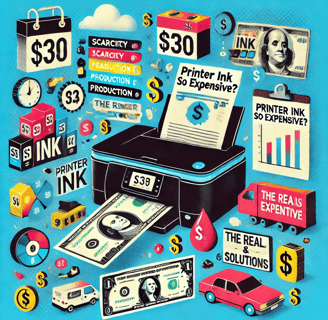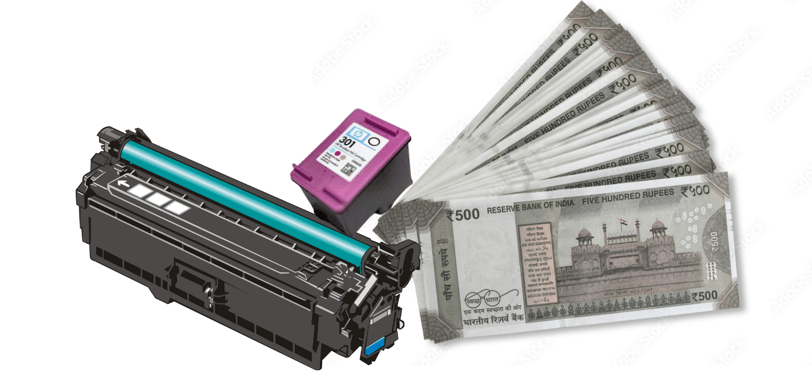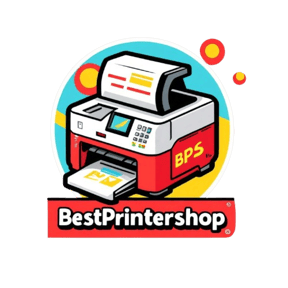Why is Printer Ink So Expensive? the Real Costs & Solutions
Learn why printer ink is so expensive and discover expert tips to reduce your printing costs. Print smarter and save more with practical solutions.
Praveen Kumar - Canon Printer Specialist
1/14/20258 min read


1. Introduction: Why is Printer Ink So Expensive?
The high cost of printer ink is a common pain point that affects countless consumers and businesses. When you walk into a store to purchase printer ink, the sticker shock can be jarring – cartridges often cost as much as or even more than entry-level printers themselves, leaving many to wonder about the seemingly inflated pricing of this essential consumable. This frustration is compounded by the rapid depletion of ink cartridges and the restrictive practices of printer manufacturers who often design their devices to work exclusively with their own branded cartridges, effectively creating a captive market. The situation creates a cycle of dependency where consumers find themselves repeatedly paying premium prices for a product that appears relatively simple to produce. Adding to the frustration, those who print frequently face mounting costs that can significantly impact their budget, while businesses must factor these expenses into their operational costs. However, understanding the factors behind these high prices and learning about cost-effective alternatives can help users make more informed decisions about their printing needs. This guide will explore the reasons behind expensive printer ink, provide practical solutions for reducing printing costs, and discuss strategies for maximizing ink efficiency, ultimately helping readers break free from the cycle of excessive printing expenses.
2. The Hidden Ink Truth: Why Your Cartridges Cost a Fortune
Printer ink. It's a small thing, but it can make a big dent in your wallet. You might wonder why those tiny cartridges cost so much. Well, there's more to the story than just the ink itself.
The Ink's Journey: From Factory to Your Printer
First, let's talk about the making of ink. It's not as simple as mixing some colors together. Creating high-quality ink involves special ingredients and a precise manufacturing process. Then, it needs to be packaged into those fancy cartridges, often with clever chips that only work with the specific printer brand. These chips and the packaging add to the cost.
And let's not forget shipping. Getting those tiny, valuable cartridges from the factory to the store involves a whole logistical operation. It's not like shipping a truckload of paper – it's more like sending out a fleet of tiny, expensive packages.
The Marketing Machine and the "Printer Trap"
Believe it or not, a big chunk of that price tag goes toward marketing and clever strategies to keep you buying their ink.
The Low-Priced Lure: You might have noticed that printers themselves are often surprisingly cheap. That's a clever trick! They know that once you buy their printer, you're more likely to stick with their ink.
The "Third-Party Trap": Using non-original ink can sometimes cause problems with your printer. This makes you feel like you have no choice but to buy their expensive cartridges.
The Advertising Blitz: You see those ads everywhere – on TV, online, in magazines. All that advertising costs money, and that cost gets passed on to you.
The Printer Companies: Controlling the Ink Market
The biggest printer companies (like HP, Canon, and Epson) pretty much rule the ink market. They can set prices higher because they know most people will pay them. It's not always about how much it actually costs to make the ink – it's about what they think they can charge.
3. Why Printer Ink Costs a Fortune: It's More Than Just the Ink
Printer ink. It's a small thing, but it can make a big dent in your wallet. You might wonder why those tiny cartridges cost so much. Well, it's not just about the hidden costs of making and shipping them – there's a lot more going on.
The Magic (and Cost) of Ink
First, let's talk about the ink itself. It's not just some colored liquid. It's a carefully crafted formula, like a secret recipe, designed to work perfectly with your printer.
A Science Experiment: Making ink is like a science experiment. It needs the right mix of ingredients to flow smoothly, dry quickly, and produce vibrant colors.
Years of Research: Companies spend a lot of time and money perfecting these formulas. It takes years of research to get the ink just right for each printer model.
The High-Tech Printer and the "Ink Trap"
Your printer is a marvel of modern engineering.
Tiny Nozzles: Imagine tiny, tiny nozzles spraying ink onto the paper – that's how inkjet printers work. It's incredibly precise technology.
Smart Cartridges: Those cartridges are smarter than they look. They have chips inside that "talk" to your printer, making sure everything works smoothly. These chips add to the cost.
The "You Can Only Use Our Ink" Trap: Many printers are designed to work exclusively with their own brand of ink. This means you're stuck buying their expensive cartridges.
The Printer Companies' Strategies
Printer companies have some clever strategies to keep those ink sales flowing.
Tiny Printers, Tiny Cartridges: They make printers smaller and smaller, which often means smaller ink cartridges. This means you have to replace them more often.
The "Starter" Trick: You often get a small "starter" cartridge with your printer. It doesn't last long, so you're encouraged to buy a full-size one quickly.
Making it "Exclusive": They design printers to only work with their own ink, giving them more control over pricing.
The Bigger Picture
The Cost of Ingredients: The price of the materials used to make ink can go up and down based on things like supply and demand.
Environmental Rules: Companies have to follow strict environmental rules, which can add to their costs.


4. Why Is Printer Ink So Expensive?
If you’ve ever been frustrated by the high cost of printer ink, you’re not alone. It’s hard to justify paying so much for what seems like a basic combination of water and pigment. So why is ink so pricey? The answer lies in smart business strategies, market dynamics, and consumer habits. Let’s break it down.
The "Razor and Blades" Strategy
Printer companies use a pricing tactic known as the “razor and blades” model. The idea is simple: sell the printer (the “razor”) at a low price, even at a loss, and make profits from selling the ink (the “blades”).
This approach ensures that once you’ve bought the printer, you’re committed to purchasing its compatible ink cartridges. By offering affordable printers, manufacturers expand their customer base. Once consumers invest in a printer, they’re unlikely to switch brands due to the cost and hassle of replacing cartridges, effectively locking them into buying ink from the same company.
Limited Competition
A big factor in the high cost of ink is the lack of competition. Most printers are designed to work only with the manufacturer’s cartridges. Major brands like HP, Epson, and Canon often use proprietary technology—like microchips in the cartridges—to block third-party options.
While third-party cartridges exist, their quality can be hit or miss, and using them might even void your printer’s warranty. As a result, many people feel stuck with the pricier branded options.
Ink Expiration Dates
Another subtle way manufacturers inflate ink costs is through expiration dates. Ink cartridges often have a limited shelf life, with claims that expired ink may degrade and affect print quality.
While this might sound reasonable, it often forces you to replace cartridges that still contain usable ink. These “freshness” policies push consumers to buy new cartridges sooner than necessary.
Convenience Costs
Let’s face it—when you run out of ink, you don’t want to waste time searching for alternatives. Printer companies know this and bank on convenience. Ink cartridges are readily available in stores, making it easy to grab the first option without scrutinizing the price.
This convenience factor, coupled with how cartridges are marketed, makes the cost feel less painful at checkout—even if the price per milliliter of ink is absurdly high compared to other liquids.
Brand Loyalty and Habits
Many consumers stick with well-known brands like HP or Canon because they trust the quality or don’t want to risk using third-party ink. Over time, this brand loyalty becomes a habit, and people stop questioning the high prices.
Manufacturers reinforce this loyalty by emphasizing quality and reliability, making consumers hesitant to explore cheaper options like refillable ink systems or alternative brands.
The Bottom Line
Printer ink prices are inflated due to a mix of clever marketing, limited competition, and consumer behavior. While alternatives like third-party ink or refillable systems exist, manufacturers have created a system that makes sticking with their products the easiest—and often most expensive—choice.
5. Practical Tips to Save Money on Printer Ink
We know printer ink can be shockingly expensive, but the good news is that there are plenty of ways to stretch your budget without sacrificing quality. Here are some practical strategies to help you save money on printer ink.
Adjust Your Printer Settings
One of the easiest ways to save ink is by tweaking your printer’s settings. Most printers offer options like "draft" or "economy" mode, which use less ink while still producing readable results.
Use these settings for everyday tasks like printing notes or web pages. You’ll extend the life of your cartridges without noticing much difference in quality for casual prints.
Print in Black and White
Whenever possible, stick to black-and-white printing. Color ink is usually more expensive, and for many documents, color isn’t necessary.
You can change the settings in your printer menu to grayscale or black-and-white mode for text-heavy documents. This small habit can lead to significant changes over time.
Print Only What You Need
Before hitting “print,” take a moment to ask yourself: Do I really need a hard copy of this? Can I save it digitally instead?
Review your documents to remove unnecessary pages, images, or ads before printing. Not only will you save ink, but you’ll also cut back on paper waste.
Invest in High-Yield Cartridges
High-yield or XL cartridges cost more upfront but hold significantly more ink, which lowers your cost per page. If you print regularly, these cartridges can be a game-changer, saving you money over the long run.
Check for XL versions of your printer’s cartridges—they’re a smart investment for frequent printers.
Explore Third-Party Ink Options
Third-party or compatible ink cartridges are often much cheaper than brand-name options. While quality can vary, many reputable companies produce cartridges that work just as well as the originals.
Read reviews and buy from trusted sellers to ensure quality. Just keep in mind that some printers may warn against using third-party cartridges or could void warranties, so it’s good to double-check your printer’s policies.
Try Refilling Your Cartridges
Consider refilling your existing cartridges instead of purchasing new ones. Many local stores and service providers offer ink refills at a fraction of the cost of new cartridges.
You can also purchase DIY refill kits if you don’t mind rolling up your sleeves. It’s a bit messy and requires some patience, but it’s a great option for budget-conscious users.
Look into Ink Subscription Services
Some manufacturers, like HP, offer subscription services where ink is automatically delivered to your door. You pay a flat fee based on your printing needs, often at a lower cost than buying cartridges individually.
These plans also monitor your ink levels, so you’ll never run out unexpectedly. If you print frequently, a subscription could save you money and hassle.
Take Advantage of Deals and Promotions
Keep an eye out for sales, rebates, or bundle deals on ink cartridges. Retailers often run promotions like “buy one, get one free” or discounts on bulk purchases.
Signing up for manufacturer newsletters or loyalty programs can also help you snag exclusive discounts and rewards for future purchases.
Consider Upgrading Your Printer
If ink costs are a constant headache, it might be time to invest in a more cost-efficient printer.
Laser Printers: Use toner instead of ink, which lasts longer and costs less per page—ideal for high-volume text printing.
Ink Tank Printers: Models like Epson’s EcoTank use refillable tanks instead of cartridges, drastically reducing the cost per page.
Though the initial price is higher, these printers are more economical in the long run, especially if you print a lot.
Final Thoughts
Saving on printer ink doesn’t have to mean sacrificing quality or convenience. By tweaking your printing habits, exploring alternative options, and staying on top of deals, you can significantly cut down your ink expenses. Small changes can add up to big savings!
Insights
Explore the latest in printer technology and tips.
Resources
Support
contact@bestprintershop.com
+918920029543
© 2024 BestPrinterShop . All rights reserved.
